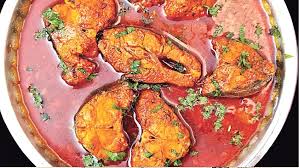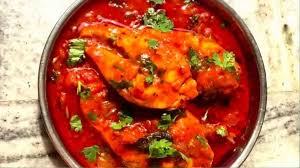
Nellore chepala pulusu
Nellore Chepala Pulusu – A Traditional Andhra Fish Curry
When we talk about authentic Andhra food, one dish that always stands out is Nellore Chepala Pulusu. This spicy and tangy fish curry has its roots in the Nellore region of Andhra Pradesh, and over the years, it has gained popularity not only across South India but also among seafood lovers all over the world. The unique cooking method, the use of tamarind juice, and the perfect balance of spices make this dish truly special. If you are a person who enjoys traditional flavors, then Nellore Chepala Pulusu should be on your must-try list.

Origin and Significance
The word Pulusu in Telugu refers to a tamarind-based gravy or curry. In Nellore, a region famous for its spicy food culture, fish is cooked in a rich tamarind broth with simple yet powerful ingredients. What makes Nellore Chepala Pulusu different from other fish curries is its distinctive taste – a balance of heat from chili powder, tanginess from tamarind, and aroma from garlic, curry leaves, and fenugreek seeds. Traditionally, this dish is prepared in an earthen pot (chatti), which enhances the flavor and gives it an earthy touch.
In many households of coastal Andhra, this dish is prepared during festivals, family gatherings, and special occasions. It has become a proud representation of Andhra coastal cuisine.
Key Ingredients That Make the Dish Authentic
The magic of Nellore Chepala Pulusu lies in its ingredients. While the recipe may sound simple, the right proportions bring out the true taste.
Fresh Fish – Rohu or Korameenu (Murrel fish) is most commonly used.
Tamarind Pulp – The soul of the curry, providing tanginess.
Onions & Tomatoes – To give thickness and richness to the gravy.
Garlic & Curry Leaves – For aroma and authentic Andhra touch.
Spices – Red chili powder, coriander powder, turmeric, and salt for balance.
Fenugreek & Mustard Seeds – Tempering ingredients that add a slight bitterness and depth.
Gingelly Oil – Traditionally used for better flavor and health benefits.
Step-by-Step Preparation
Extract Tamarind Juice – Soak tamarind in warm water and squeeze out a thick pulp.
Prepare the Base – In an earthen pot, heat gingelly oil and add mustard seeds, fenugreek seeds, garlic, and curry leaves.
Add Onions and Tomatoes – Fry until onions turn golden brown and tomatoes become soft.
Mix Spices – Add chili powder, coriander powder, turmeric, and salt. Fry until oil separates.
Pour Tamarind Extract – Allow the gravy to boil until the raw smell of tamarind disappears.
Cook the Fish – Gently slide in the cleaned fish pieces. Avoid stirring with a spoon; instead, rotate the pot slightly to prevent breaking the fish.
Simmer – Cook on a low flame until fish absorbs the flavors and oil floats on top.
Resting Period – Nellore Chepala Pulusu tastes best after 2–3 hours as the flavors blend beautifully.
Serving Suggestions
Always serve Nellore Chepala Pulusu hot with steamed white rice.
Adding a spoon of ghee on rice enhances the experience.
Pair with Andhra-style omelet, fish fry, or simple vegetable stir fry.
It also goes well with ragi mudde or jowar roti for a rustic touch.
Health Benefits of Nellore Chepala Pulusu
Apart from being delicious, this traditional fish curry is also packed with nutrition.

High Protein – Fresh fish provides lean protein essential for muscle growth.
Omega-3 Fatty Acids – Good for heart health and brain development.
Tamarind – Helps in digestion and adds antioxidants.
Garlic & Curry Leaves – Boost immunity and add medicinal benefits.
Thus, it is not just a flavorful dish but also a healthy choice for regular meals.
Why Nellore Chepala Pulusu Stands Out
Among the countless Indian fish curries, Nellore Chepala Pulusu has a unique place because of:
Authenticity – Rooted in Andhra’s coastal culture.
Tangy-Spicy Balance – A perfect harmony of flavors.
Earthen Pot Cooking – Brings out rustic taste.
Versatility – Can be made with different varieties of fish.
